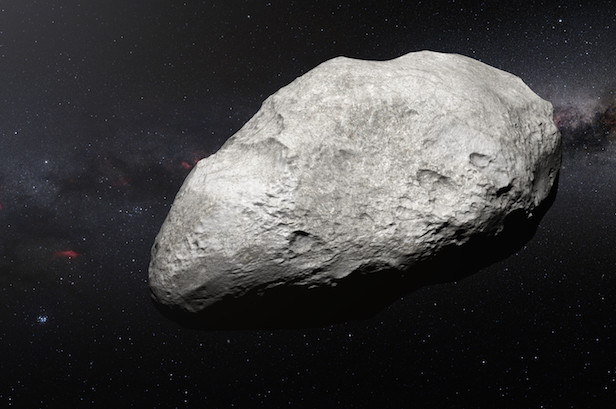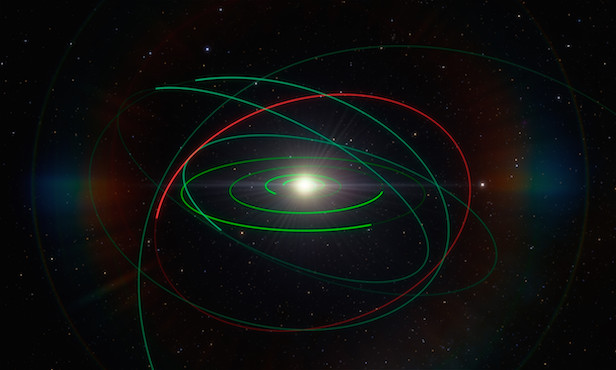Exiled asteroid found in the Kuiper Belt
Astronomers confirm the existence of the first carbon-rich lump of space rock in the outer reaches of the Solar System

The carbon-rich asteroid 2004 EW95 is a relic of the early Solar System, exiled at an early age. Image credit: ESO/M. Kornmesser
In the freezing realm beyond Neptune, known as the Kuiper Belt, lurks the first carbon-rich asteroid ever discovered that far out in the Solar System. An international team of astronomers used European Southern Observatory (ESO)’s telescopes to examine the Kuiper Belt Object (KBO) 2004 EW95, which astronomers now believe originally formed in the asteroid belt between Mars and Jupiter and then was flung beyond the orbit of Neptune into its new home.
Collisions, crashes and catastrophe wreaked havoc in the early Solar System, when the gas giants dominated proceedings. Theoretical models predict that the gas giants would take small rocky bodies from the inner part of our solar neighbourhood and eject them to the farthest reaches beyond Neptune. In principle, this would mean a small number of rock bodies should be found in the Kuiper Belt, such as carbon-rich asteroids formally known as carbonaceous asteroids.
This recent research presents evidence for the first reliably observed carbonaceous asteroid found in the Kuiper Belt region, with therefore strengthens the argument for these theoretical models of the young Solar System. This study utilised multiple instruments were used at ESO’s Very Large Telescope (VLT), and was the brainchild of a team of international researchers and led by Tom Seccull of the Queen’s University Belfast in the United Kingdom. This team of astronomers were able to deduce the composition of the anomalous KBO 2004 EW95, thus uncovering its carbon-rich nature. This is a strong indication that its birthplace was in the inner Solar System, and then migrated outwards in its evolution.
2004 EW95 first aroused curiosity during routine observations using NASA/ESA’s Hubble Space Telescope, conducted by Wesley Fraser who is an astronomer also at Queen’s University Belfast. The asteroid’s reflectance spectrum, which is the specified pattern of wavelengths of light reflected from an object, was much different from any other small KBO. The spectra for regular KBOs are fairly mundane, featureless and show little information about their composition.
“The reflectance spectrum of 2004 EW95 was clearly distinct from the other observed outer Solar System objects,” explains Seccull. “It looked enough of a weirdo for us to take a closer look.”
Using the X-Shooter and FORS2 instruments equipped to the VLT, extremely sensitive spectrographs were taken. The light reflected from the asteroid was collected with great precision, and the patterns of light seen inferred the composition. However the VLT still found it difficult to observe 2004 EW95, even with its impressive light-gathering capability. The asteroid may be an enormous 300 kilometres (186 miles) wide, which is roughly the same distance between London and Liverpool in the United Kingdom, but as it is located over four billion kilometres (2.5 billion miles) away from Earth, it is nothing more then a speck of light which is immensely hard to analyse.

The orbit of 2004 EW95, shown in red, stretches way beyond the orbit of Neptune and is much more inclined compared to the Solar System’s planetary disk. Image credit: ESO/L. Calçada
“It’s like observing a giant mountain of coal against the pitch-black canvas of the night sky,” says Thomas Puzia from the Pontificia Universidad Católica de Chile.
“Not only is 2004 EW95 moving, it’s also very faint,” adds Seccull. “We had to use a pretty advanced data processing technique to get as much out of the data as possible.”
When astronomers were able to get their hands on the object’s spectra, there were two particular features that drew attention. The two features correspond to the presence of ferric oxides and phyllosilicates, both of which have never been confirmed in a KBO before and strongly hints to the idea that 2004 EW95 wasn’t born in that region.
Seccull concludes, “Given 2004 EW95’s present-day abode in the icy outer reaches of the Solar System, this implies that it has been flung out into its present orbit by a migratory planet in the early days of the Solar System.”
“While there have been previous reports of other ‘atypical’ Kuiper Belt Object spectra, none were confirmed to this level of quality,” comments Olivier Hainaut, an ESO astronomer who was not part of the team. “The discovery of a carbonaceous asteroid in the Kuiper Belt is a key verification of one of the fundamental predictions of dynamical models of the early Solar System.”
Keep up to date with the latest reviews in All About Space – available every month for just £4.99. Alternatively you can subscribe here for a fraction of the price!




